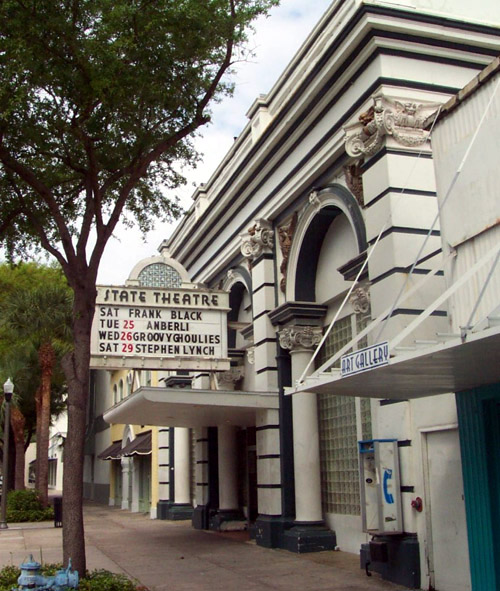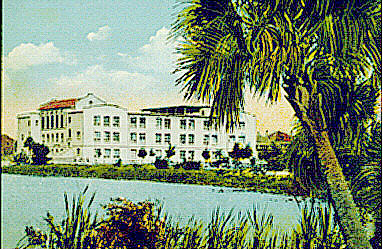
ST.PETERSBURG (Florida)
THE CITY WITH THE PIER
SAINT PETERSBURG AREA CHAMBER OF COMMERCE *** SAINT PETERSBURG MUSEUM OF HISTORY
SAINT PETERSBURG PRESERVATION
WHERE TO
START: START AT the parking lots of ST. PETERSBURG
PIER at the end of Second Avenue NE. The pier has been redone although I still miss the more commercial pier, but it is done after years of fights over architecture and facilities. This tour may be driven
by automobile with suggest stops (MAP) or walked in two hours. Saint Petersburg is undergoing a huge construction boom, particularly nearer the waterfront. Beach Drive is loaded iwth restaurants with near outdoor patios although the road and Straub Park blocks most water views.

(1) ST. PETERSBURG PIER (1988), 800
Second Avenue, has been the landmark of downtown
since l899 when Peter Demens hooked up his Orange
Belt Railroad to a half mile wharf. D. F. Brantley started the first pier
pavilion in 1895, but it is the 1926 Million Dollar Pier torn down for today's
pyramid that postcard collectors and real old-timers remember. The new pier may have a bunch of interactive sites and a few restaurants, but most critics question it will be the landmark of the earlier piers.
If you want to start at the Pier, PARK at the
pier lots and take the trolley to visit the shops and
restaurants. The Pier is finally shaping out after years of delays and battles. It does not have all the facilities that might be added. At the foot of the pier on the north side is the: (2) ST.
PETERSBURG HISTORICAL MUSEUM, 332 Second Avenue, a new temple filled
with a treasure of artifacts and documents. They have an autographed baseball collection that is the largest in the world. Right next door is the unusual (3)
COMFORT STATION # 1 (1927), a Romanesque Revival public restroom designed
by Henry Taylor to match is downtown St. Mary Catholic Church. The interior of
black and white tiled bathrooms are delightful.
CROSS BAYSHORE DRIVE past (4) WILLIAM L. STRAUB PARK,
honoring the St. Petersburg Times editor who saved these thirty blocks and
created a Riviera-style waterfront. Art lovers will wish to TURN RIGHT to the:
(5) MUSEUM OF FINE ARTS (1965), 255 Beach Drive, a Mediterranean
villa with a tea garden and the West Coast's best collection of Impressionist
paintings.
DRIVE SOUTH ON BEACH DRIVE past the site of the (6)
SORENO HOTEL
(1923), 110 Beach Drive,
first of the city's big Boom Time hotels. Danish hotelier Soren
Lund's edifice was ingloriously blown up for the final trailer in the film Lethal Weapon III.
. One block down there is total redesign at
the (7) ST. PETERSBURG YACHT CLUB, started in 1909 to bring in
sailors by newsman A. T. Roberts. TURN RIGHT ON CENTRAL AVENUE, the city's main
commercial artery. On the right at 94
Central Avenue is the (8) PONCE DE LEON HOTEL
(1922), an arcaded Mediterranean typical of
the smaller Boom hotels.


Downtown View From
St Pete Pier
Fountain in Mirror
Lake


Postcard of Old St Pete High
Open-Air Post Office
TURN RIGHT
ON FIRST STREET, then LEFT ON FIRST AVENUE,
and finally LEFT ON SECOND STREET. This block is now condo row. I recall the buildings that once stood here. On your left at 25 Second Street,was the (9) FLORENTINE
HOTEL (1910), the oldest masonry hotel still standing. nearby was the small (10) BRANTLEY BUILDING (1888), 17 Second Streetbuilt first to house Demens'
railroad workers. The last building on the left was the (11) HENRI HOTEL
(1909), 173 Central Avenue,
still maintaining its balconies. Besides the waterfront area, Central Avenue is filling up with interesting shops and restaurants, but they are mainly in original, historic structures.
TURN RIGHT ON busy CENTRAL AVENUE.
On your right is the (14) ST.CHARLES HOTEL (1903), a fine
balconied edifice. Next door is the (12) DETROIT HOTEL (1888), 215 Central Avenue,
built by Peter Demens and John Williams. It has been
greatly modified since the days William J. Bryan, Clarence Darrow, and Babe
Ruth. It has personality compared to skyscrapers like the 26 story (13) BARNETT TOWER. Look
behind the Detroit
and spy the outdoor stages of JANNUS LANDING, a popular nightclub.
TURN LEFT ON THIRD STREET, GO TWO
BLOCKS TO SECOND AVENUE SOUTH, where to your left, you'll see
the site of the: (15) NUMBER ONE FIRE STATION (1911), 220 3rd Street, the
city's first station.
TURN RIGHT ON SECOND AVENUE TO FOURTH
STREET past the: (16) TREMOR CAFETERIA
(1924), 119 4th Street,
with its colorful Spanish tiles and stylish porches. World War II veterans
remember the dances at the canteen.
GO NORTH ON 4TH STREET
TO CENTRAL AVENUE.
You notice the south side of Central is lined with modern structures like the FLORIDA FEDERAL
TOWER (1989) and the FIRST UNION
BUILDING (1983). On the
north side of Central, you'll see the facades of the older downtown: the (17)
RUTLAND
BUILDING (1925), 405
Central Avenue, and the modernized (18) McCRORY HOTEL (1904, 425 Central Avenue.
Easily
noticeable for its glazed terra cotta design is the (19) KRESS BUILDING
(1927) at 485 Central Avenue.
TURN LEFT ON CENTRAL AVENUE and continue west down the 500 block where the
featured gem on the right is the (20) ALEXANDER HOTEL
(1919), 535 Central Avenue, a National Registrar Beaux-Arts twin- towered hotel
by Atlantan Neel Reid.
The next block includes another Neel Reid
structure, the still active with shows (21) STATE THEATER (1924),
a Doric temple at 685 Central Avenue, and the (22) GREEN ARCADE
(1924), 689 Central Avenue.
TURN RIGHT ON 7TH AVENUE
and RIGHT ON ARLINGTON to reach: MIRROR
LAKE, once Weir Lake,
the city's first reservoir. At 719
Arlington Avenue is the (23) UNITARIAN-UNIVERSALIST CHURCH (1926), a good Spanish
Colonial mission with an interior of dark wood beams.

Mirror Lake is a good place to stroll CLOCKWISE (WHICH IS THE
ORDER I WILL LIST BUILDINGS). DRIVERS MUST TRAVEL AROUND THE LAKE
COUNTERCLOCKWISE so study our maps.
Walkers going
clockwise will see the: (24) OLD ST. PETERSBURG JUNIOR HIGH (1924),
294 Mirror Lake Drive,
and the (25) OLD ST.
PETERSBURG HIGH
SCHOOL (1919), 709 Mirror Lake. Florida's oldest community college, St. Petersburg Junior
College has its roots here.
Surrounded by courts is the famous (26) ST.
PETERSBURG LAWN BOWLING CLUB (1926), 536 4th Avenue, the world's
largest shuffleboard center and home to the National Shuffleboard Hall of Fame.
NOTICE TO THE NORTH the facade of the (27) COLISEUM (1924), 535 4th Street,
home to generations of ballroom dancers and host to the greatest big bands of
all time. You may recall the building as where Don Ameche
displayed his Academy Award winning dance form in the movie CACOON.

At the east end of the Lake
is the Neoclassical Revival (28) CARNEGIE LIBRARY (1915), 300 3rd Street, the
city's first library, with popular gardens by the Sunshine Senior Citizens
Center.
FROM 5TH
STREET, TURN EAST (LEFT IF YOU WENT CLOCKWISE) ON
SECOND AVENUE. You soon note the (29) ST. PETERSBURG CITY HALL
(1939), 175 5th Street, a three story Mediterranean Revival design by Lawther Forrest for the W.P.A.
Behind City Hall
is the (30) MANUAL TRAINING SCHOOL (1902), used as a City Hall
Annex, but set up by Edwin Tomlinson, a silver mining tycoon who was the savior
of vocational education in the community. Next door is the (31) ST. PETERSBURG
CATHEDRAL (1889), 140 4th
Street, a Greek Revival
church housing the city's second oldest Episcopal congregation.
YOU HAVE REACHED 4TH STREET on the spot where a local realtor placed the
first sidewalk bench in St. Petersburg.
Across the way is: (32) WILLIAMS PARK, the city's transportation
core and Colonel John C. Williams' plaza of 1888.
 I TURN RIGHT ON 4TH STREET past the: (33) FIRST
BAPTIST CHURCH (1924), 136
4th Street, a good Neo- Classical Revival. YOU
WILL TURN LEFT ON FIRST AVENUE,
but you'd like to stop to batter notice on your right the (34) PRINCESS
MARTHA HOTEL (1923), 401
First Avenue, (see photo) designed by Boston's Ed Jonsberg at the start of the Land Boom.
I TURN RIGHT ON 4TH STREET past the: (33) FIRST
BAPTIST CHURCH (1924), 136
4th Street, a good Neo- Classical Revival. YOU
WILL TURN LEFT ON FIRST AVENUE,
but you'd like to stop to batter notice on your right the (34) PRINCESS
MARTHA HOTEL (1923), 401
First Avenue, (see photo) designed by Boston's Ed Jonsberg at the start of the Land Boom.
Across the street on the right is a city
landmark, the: (35) OPEN-AIR POST OFFICE (1917), 400 lst Avenue, a granite Spanish Colonial structure with
arcades where once all postboxes faced the sunshine. Behind the post office and
best seen by foot is the wonderful: (36) SNELL ARCADE BUILDING
(1926), main entrance on 405 Central Avenue, designed by Richard Kiehnel for developer Peter Snell. The elaborate floor
arcade with its extravagant art work merits an interior visit and National
Registrar salute.
TURN
LEFT ON FIRST AVENUE between the Park and the (37) DENNIS (McCARTHY) HOTEL (1925), 326 First Avenue, Henry Cunnningham's Neoclassical residence hotel.
TURN LEFT ON THIRD STREET.
On the left past the Park is the huge brick facade of the (38) FIRST
UNITED METHODIST CHURCH (1924), 212 Third
Street. Across the street are some of downtown's mansions: the (39) JAMES
ENDICOTT HOUSE (l916), 233
Third Street. a shingle
house of a judge.
PASS THIRD AVENUE on the right is the (40) MARTHA WASHINGTON HOTEL
(1928), 234 Third Avenue,
part of which is a Victorian cottage. TURN RIGHT ON FOURTH AVENUE to see at 262 4th Avenue, the
(41) RALPH VEILLARD HOUSE (1910), a Queen Anne bungalow designed
by Henry DuPont for a pioneer automobile dealer. Across the street at 259 4th Avenue, is
the (42) FRANK DAVENPORT HOUSE (1906). A third house is the (43)
HENRY BUSSEY HOUSE (1904).
As you head toward the water you can’t help notice the growth of condo highrise units and the former Baywalk area now the SUNDIAL SHOPPING & ENTERTAINMENT CENTER.
TURN LEFT ON SECOND AVENUE going toward the Pier. On your way notice the
endangered (44) PERRY SNELL HOUSE (l904), 105 Second Avenue, the frame house of the
developer of the city's finest Land Boom suburb Snell Isles.








 I TURN RIGHT ON
I TURN RIGHT ON